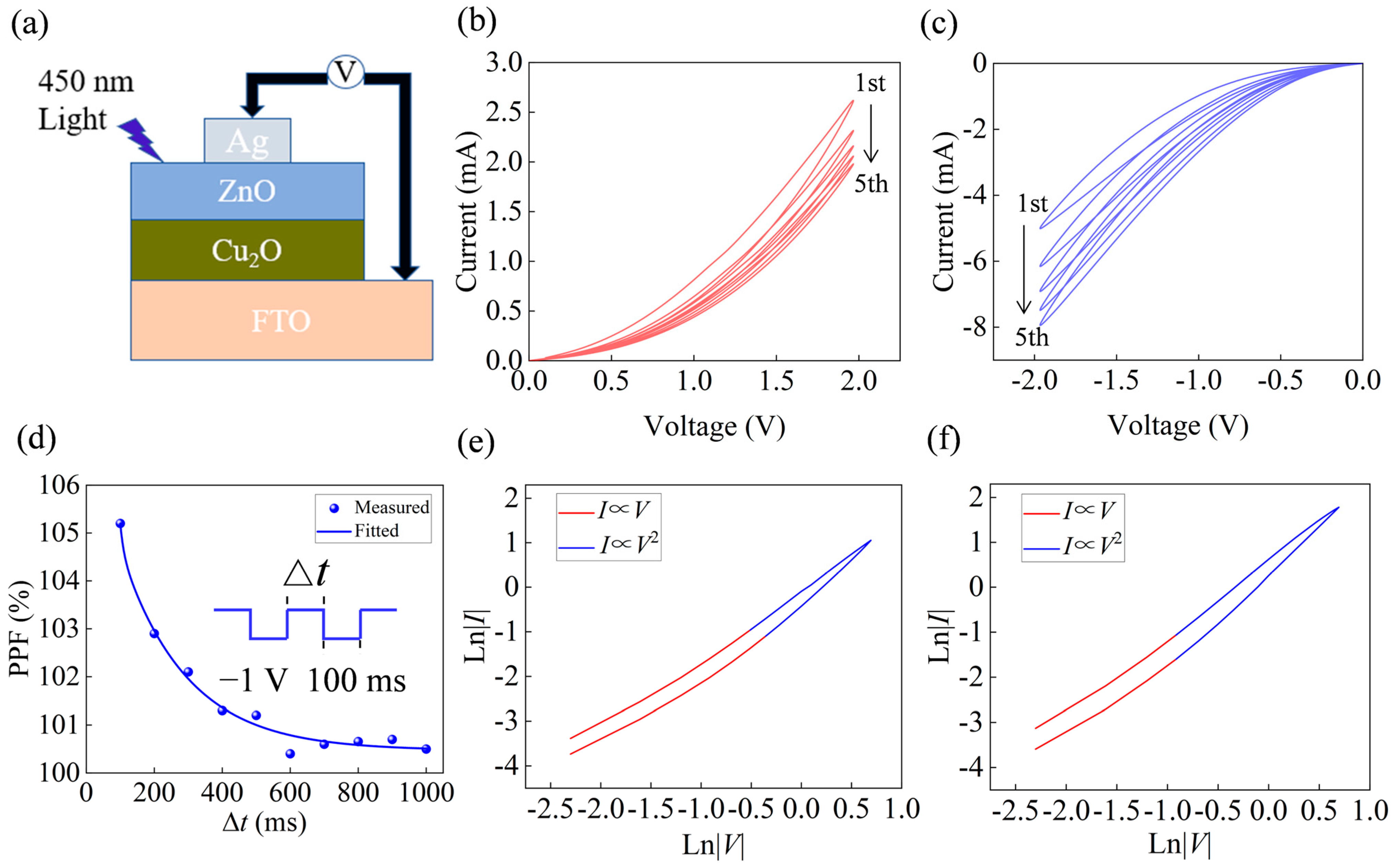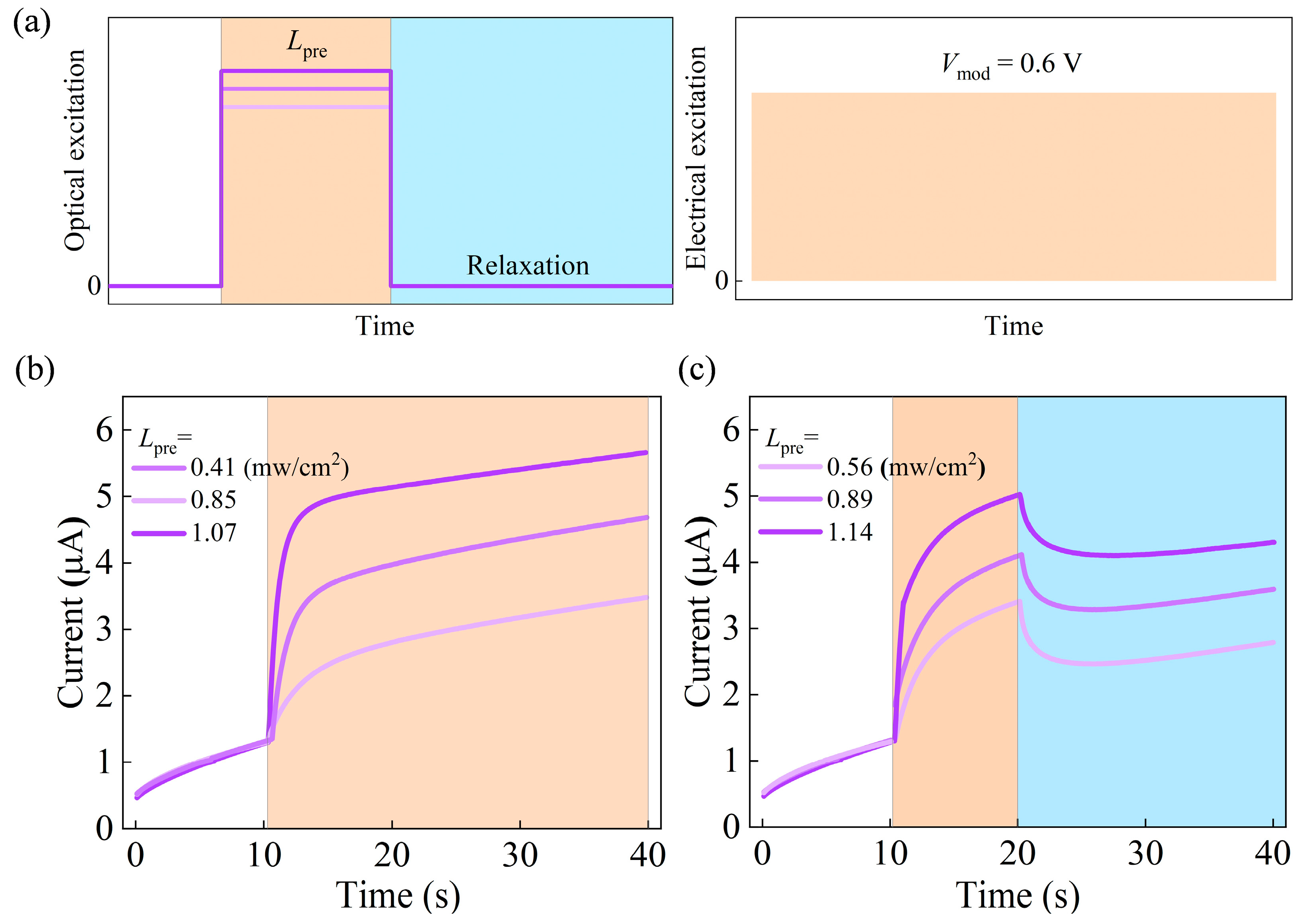Optoelectronic Memristor Based on ZnO/Cu2O for Artificial Synapses and Visual System
Abstract
1. Introduction
2. Materials and Methods
3. Results
3.1. Electrical Performance Testing
3.2. Optical Performance Testing
3.3. Mechanistic Explanation
4. Discussion
Supplementary Materials
Author Contributions
Funding
Data Availability Statement
Acknowledgments
Conflicts of Interest
References
- Li, G.; Xie, D.; Zhong, H.; Zhang, Z.; Fu, X.; Zhou, Q.; Li, Q.; Ni, H.; Wang, J.; Guo, E.J.; et al. Photo-induced non-volatile VO(2) phase transition for neuromorphic ultraviolet sensors. Nat. Commun. 2022, 13, 1729. [Google Scholar] [CrossRef] [PubMed]
- Zhang, L.; Yu, H.; Xiao, C.; Si, J.; Xu, H.; Zhu, W.; Wang, L. Building Light Stimulated Synaptic Memory Devices for Visual Memory Simulation. Adv. Electron. Mater. 2021, 7, 2000945. [Google Scholar] [CrossRef]
- Lee, H.R.; Lee, D.; Oh, J.H. A Hippocampus-Inspired Dual-Gated Organic Artificial Synapse for Simultaneous Sensing of a Neurotransmitter and Light. Adv. Mater. 2021, 33, 2100119. [Google Scholar] [CrossRef]
- Li, Y.; Wang, J.H.; Yang, Q.; Shen, G.Z. Flexible Artificial Optoelectronic Synapse based on Lead-Free Metal Halide Nanocrystals for Neuromorphic Computing and Color Recognition. Adv. Sci. 2022, 9, 2202123. [Google Scholar] [CrossRef]
- Yang, X.; Xiong, Z.; Chen, Y.; Ren, Y.; Zhou, L.; Li, H.; Zhou, Y.; Pan, F.; Han, S.T. A self-powered artificial retina perception system for image preprocessing based on photovoltaic devices and memristive arrays. Nano Energy 2020, 78, 105246. [Google Scholar] [CrossRef]
- Sun, F.; Lu, Q.; Feng, S.; Zhang, T. Flexible Artificial Sensory Systems Based on Neuromorphic Devices. ACS Nano 2021, 15, 3875–3899. [Google Scholar] [CrossRef] [PubMed]
- Jaafar, A.H.; Kemp, N.T. Light-Mediated Multilevel Neuromorphic Switching in a Hybrid Organic–Inorganic Memristor. ACS Omega 2024, 9, 51641–51651. [Google Scholar] [CrossRef] [PubMed]
- Strukov, D.B.; Snider, G.S.; Stewart, D.R.; Williams, R.S. The missing memristor found. Nature 2008, 453, 80–83. [Google Scholar] [CrossRef]
- Jo, S.H.; Chang, T.; Ebong, I.; Bhadviya, B.B.; Mazumder, P.; Lu, W. Nanoscale Memristor Device as Synapse in Neuromorphic Systems. Nano Lett. 2010, 10, 1297–1301. [Google Scholar] [CrossRef]
- Mao, J.-Y.; Zhou, L.; Zhu, X.; Zhou, Y.; Han, S.-T. Photonic Memristor for Future Computing: A Perspective. Adv. Opt. Mater. 2019, 7, 1900766. [Google Scholar] [CrossRef]
- Shan, X.; Zhao, C.; Wang, X.; Wang, Z.; Fu, S.; Lin, Y.; Zeng, T.; Zhao, X.; Xu, H.; Zhang, X.; et al. Plasmonic Optoelectronic Memristor Enabling Fully Light-Modulated Synaptic Plasticity for Neuromorphic Vision. Adv. Sci. 2022, 9, 2104632. [Google Scholar] [CrossRef] [PubMed]
- Yue, L.; Sun, H.; Zhu, Y.; Li, Y.; Yang, F.; Dong, X.; Chen, J.; Zhang, X.; Chen, J.; Zhao, Y.; et al. Electrical-Light Coordinately Modulated Synaptic Memristor Based on Ti3C2 MXene for Near-Infrared Artificial Vision Applications. J. Phys. Chem. Lett. 2024, 15, 8667–8675. [Google Scholar] [CrossRef]
- Wen, Y.; Cao, Y.; Ren, H.; Du, X.; Guo, J.; Wu, Z.; Liu, W.; Du, J.; Zhang, Y. Ferroelectric Optical Memristors Enabled by Non-Volatile Electro-Optic Effect. Adv. Mater. 2025, 37, 2417658. [Google Scholar] [CrossRef]
- Hu, L.; Yang, J.; Wang, J.; Cheng, P.; Chua, L.O.; Zhuge, F. All-Optically Controlled Memristor for Optoelectronic Neuromorphic Computing. Adv. Funct. Mater. 2021, 31, 2005582. [Google Scholar] [CrossRef]
- Kumar, D.; Bharti, R.; Li, H.; Kumbhar, D.D.; El-Atab, N. Optoelectronic wide-band-gap oxide-based memristor for mimicking human eye sensory perception and object tracking. Cell Rep. Phys. Sci. 2024, 5, 102144. [Google Scholar] [CrossRef]
- Wang, X.; Chen, F.; Li, X.; Xiang, T.; Wang, L. Emulation of Optoelectronic Synaptic Behavior in a MoS2/WSe2-Based p–n van der Waals Heterostructure Memtransistor. ACS Appl. Electron. Mater. 2024, 6, 4311–4320. [Google Scholar] [CrossRef]
- Kim, H.; Lee, K.; Zan, G.; Shin, E.; Kim, W.; Zhao, K.; Jang, G.; Moon, J.; Park, C. Chiroptical Synaptic Perovskite Memristor as Reconfigurable Physical Unclonable Functions. ACS Nano 2025, 19, 691–703. [Google Scholar] [CrossRef]
- Li, X.; Fang, Z.; Guo, X.; Wang, R.; Zhao, Y.; Zhu, W.; Wang, L.; Zhang, L. Light-Induced Conductance Potentiation and Depression in an All-Optically Controlled Memristor. ACS Appl. Mater. Interfaces 2024, 16, 27866–27874. [Google Scholar] [CrossRef]
- Zheng, J.; Du, Y.; Dong, Y.; Shan, X.; Tao, Y.; Lin, Y.; Zhao, X.; Wang, Z.; Xu, H.; Liu, Y. Fully light-modulated memristor based on ZnO/MoOx heterojunction for neuromorphic computing. Appl. Phys. Lett. 2024, 124, 133502. [Google Scholar] [CrossRef]
- Zhou, Z.; Pei, Y.; Zhao, J.; Fu, G.; Yan, X. Visible light responsive optoelectronic memristor device based on CeOx/ZnO structure for artificial vision system. Appl. Phys. Lett. 2021, 118, 191103. [Google Scholar] [CrossRef]
- Yin, S.; Song, C.; Sun, Y.; Qiao, L.; Wang, B.; Sun, Y.; Liu, K.; Pan, F.; Zhang, X. Electric and Light Dual-Gate Tunable MoS2 Memtransistor. ACS Appl. Mater. Interfaces 2019, 11, 43344–43350. [Google Scholar] [CrossRef] [PubMed]
- Li, R.; Wang, W.; Li, Y.; Gao, S.; Yue, W.; Shen, G. Multi-modulated optoelectronic memristor based on Ga2O3/MoS2 heterojunction for bionic synapses and artificial visual system. Nano Energy 2023, 111, 108398. [Google Scholar] [CrossRef]
- Cheng, Y.K.; Li, Z.Z.; Lin, Y.; Wang, Z.Q.; Shan, X.Y.; Tao, Y.; Zhao, X.N.; Xu, H.Y.; Liu, Y.C. Color Recognition Achieved in Multiwavelength Controlled Plasmonic Optoelectronic Memristor for Neuromorphic Visual System. Adv. Funct. Mater. 2024, 35, 2414404. [Google Scholar] [CrossRef]
- Shrivastava, S.; Dai, W.S.; Limantoro, S.E.; Juliano, H.; Tseng, T.Y. A Violet-Light-Responsive ReRAM Based on Zn2SnO4/Ga2O3 Heterojunction as an Artificial Synapse for Visual Sensory and In-Memory Computing. Adv. Electron. Mater. 2024, 11, 2400527. [Google Scholar] [CrossRef]
- Shan, X.; Zhao, C.; Lin, Y.; Liu, J.; Zhang, X.; Tao, Y.; Wang, C.; Zhao, X.; Wang, Z.; Xu, H.; et al. Optoelectronic synaptic device based on ZnO/HfOx heterojunction for high-performance neuromorphic vision system. Appl. Phys. Lett. 2022, 121, 263501. [Google Scholar] [CrossRef]
- Li, Z.; Zou, G.; Xiao, Y.; Feng, B.; Huo, J.; Peng, J.; Sun, T.; Liu, L. MoS2/ZnO-heterostructured optoelectronic synapse for multiwavelength optical information-based sensing, memory, and processing. Nano Energy 2024, 127, 109733. [Google Scholar] [CrossRef]
- Yang, J.; Hu, L.; Shen, L.; Wang, J.; Cheng, P.; Lu, H.; Zhuge, F.; Ye, Z. Optically driven intelligent computing with ZnO memristor. Fundam. Res. 2024, 4, 158–166. [Google Scholar] [CrossRef]
- Yin, S.; Jiang, Z.; Kim, M.; Gupta, T.; Seok, M.; Seo, J.S. Vesti: Energy-Efficient In-Memory Computing Accelerator for Deep Neural Networks. IEEE Trans. Very Large Scale Integr. (VLSI) Syst. 2020, 28, 48–61. [Google Scholar] [CrossRef]
- Antolini, A.; Lico, A.; Zavalloni, F.; Scarselli, E.F.; Gnudi, A.; Torres, M.L.; Canegallo, R.; Pasotti, M. A Readout Scheme for PCM-Based Analog In-Memory Computing With Drift Compensation Through Reference Conductance Tracking. IEEE Open J. Solid-State Circuits Soc. 2024, 4, 69–82. [Google Scholar] [CrossRef]
- Khan, R.; Raziq, F.; Ahmad, I.; Ghosh, S.; Kheawhom, S.; Sangaraju, S. Reliable Resistive Switching and Multifunctional Synaptic Behavior in ZnO/NiO Nanocomposite Based Memristors for Neuromorphic Computing. Acs. Appl. Electron. Mater. 2024, 7, 73–85. [Google Scholar] [CrossRef]
- Han, C.; Han, X.; Han, J.; He, M.; Peng, S.; Zhang, C.; Liu, X.; Gou, J.; Wang, J. Light-Stimulated Synaptic Transistor with High PPF Feature for Artificial Visual Perception System Application. Adv. Funct. Mater. 2022, 32, 2113053. [Google Scholar] [CrossRef]
- Teja Nibhanupudi, S.S.; Roy, A.; Veksler, D.; Coupin, M.; Matthews, K.C.; Disiena, M.; Singh, J.V.; Gearba-Dolocan, I.R.; Warner, J.; Kulkarni, J.P.; et al. Ultra-fast switching memristors based on two-dimensional materials. Nat. Commun. 2024, 15, 2334. [Google Scholar] [CrossRef]
- Wang, I.T.; Chang, C.-C.; Chiu, L.-W.; Chou, T.; Hou, T.-H. 3D Ta/TaOx/TiO2/Ti synaptic array and linearity tuning of weight update for hardware neural network applications. Nanotechnology 2016, 27, 365204. [Google Scholar] [CrossRef]
- Hao, D.; Yang, Z.; Huang, J.; Shan, F. Recent Developments of Optoelectronic Synaptic Devices Based on Metal Halide Perovskites. Adv. Funct. Mater. 2023, 33, 2211467. [Google Scholar] [CrossRef]
- Zhong, Y.; Yin, J.; Li, M.; He, Y.; Lei, P.; Zhong, L.; Liao, K.; Wu, H.; Wang, Z.; Jie, W. High-performance memristor for energy-efficient artificial optoelectronic synapse based on BiVO4 nanosheets. J. Alloys Compd. 2024, 991, 174533. [Google Scholar] [CrossRef]
- Chen, X.; Chen, B.; Jiang, B.; Gao, T.; Shang, G.; Han, S.-T.; Kuo, C.-C.; Roy, V.A.L.; Zhou, Y. Nanowires for UV–vis–IR Optoelectronic Synaptic Devices. Adv. Funct. Mater. 2023, 33, 2208807. [Google Scholar] [CrossRef]
- Li, Y.; Sun, H.; Yue, L.; Yang, F.; Dong, X.; Chen, J.; Zhang, X.; Chen, J.; Zhao, Y.; Chen, K.; et al. Multicolor Fully Light-Modulated Artificial Synapse Based on P-MoSe2/PxOy Heterostructured Memristor. J. Phys. Chem. Lett. 2024, 15, 8752–8758. [Google Scholar] [CrossRef]
- Yang, W.; Kan, H.; Shen, G.; Li, Y.A. Network Intrusion Detection System with Broadband WO3–x/WO3–x-Ag/WO3–x Optoelectronic Memristor. Adv. Funct. Mater. 2024, 34, 2312885. [Google Scholar] [CrossRef]
- Jabeen, S.; Ismail, M.; Rana, A.M.; Ahmed, E. Impact of work function on the resistive switching characteristics of M/ZnO/CeO2/Pt devices. Mater. Res. Express 2017, 4, 056401. [Google Scholar] [CrossRef]
- Murali, D.S.; Aryasomayajula, S. Thermal conversion of Cu4O3 into CuO and Cu2O and the electrical properties of magnetron sputtered Cu4O3 thin films. Appl. Phys. A 2018, 124, 279. [Google Scholar] [CrossRef]






Disclaimer/Publisher’s Note: The statements, opinions and data contained in all publications are solely those of the individual author(s) and contributor(s) and not of MDPI and/or the editor(s). MDPI and/or the editor(s) disclaim responsibility for any injury to people or property resulting from any ideas, methods, instructions or products referred to in the content. |
© 2025 by the authors. Licensee MDPI, Basel, Switzerland. This article is an open access article distributed under the terms and conditions of the Creative Commons Attribution (CC BY) license (https://creativecommons.org/licenses/by/4.0/).
Share and Cite
Meng, C.; Liu, H.; Li, T.; Luo, J.; Zhang, S. Optoelectronic Memristor Based on ZnO/Cu2O for Artificial Synapses and Visual System. Electronics 2025, 14, 2490. https://doi.org/10.3390/electronics14122490
Meng C, Liu H, Li T, Luo J, Zhang S. Optoelectronic Memristor Based on ZnO/Cu2O for Artificial Synapses and Visual System. Electronics. 2025; 14(12):2490. https://doi.org/10.3390/electronics14122490
Chicago/Turabian StyleMeng, Chen, Hongxin Liu, Tong Li, Jin Luo, and Sijie Zhang. 2025. "Optoelectronic Memristor Based on ZnO/Cu2O for Artificial Synapses and Visual System" Electronics 14, no. 12: 2490. https://doi.org/10.3390/electronics14122490
APA StyleMeng, C., Liu, H., Li, T., Luo, J., & Zhang, S. (2025). Optoelectronic Memristor Based on ZnO/Cu2O for Artificial Synapses and Visual System. Electronics, 14(12), 2490. https://doi.org/10.3390/electronics14122490





